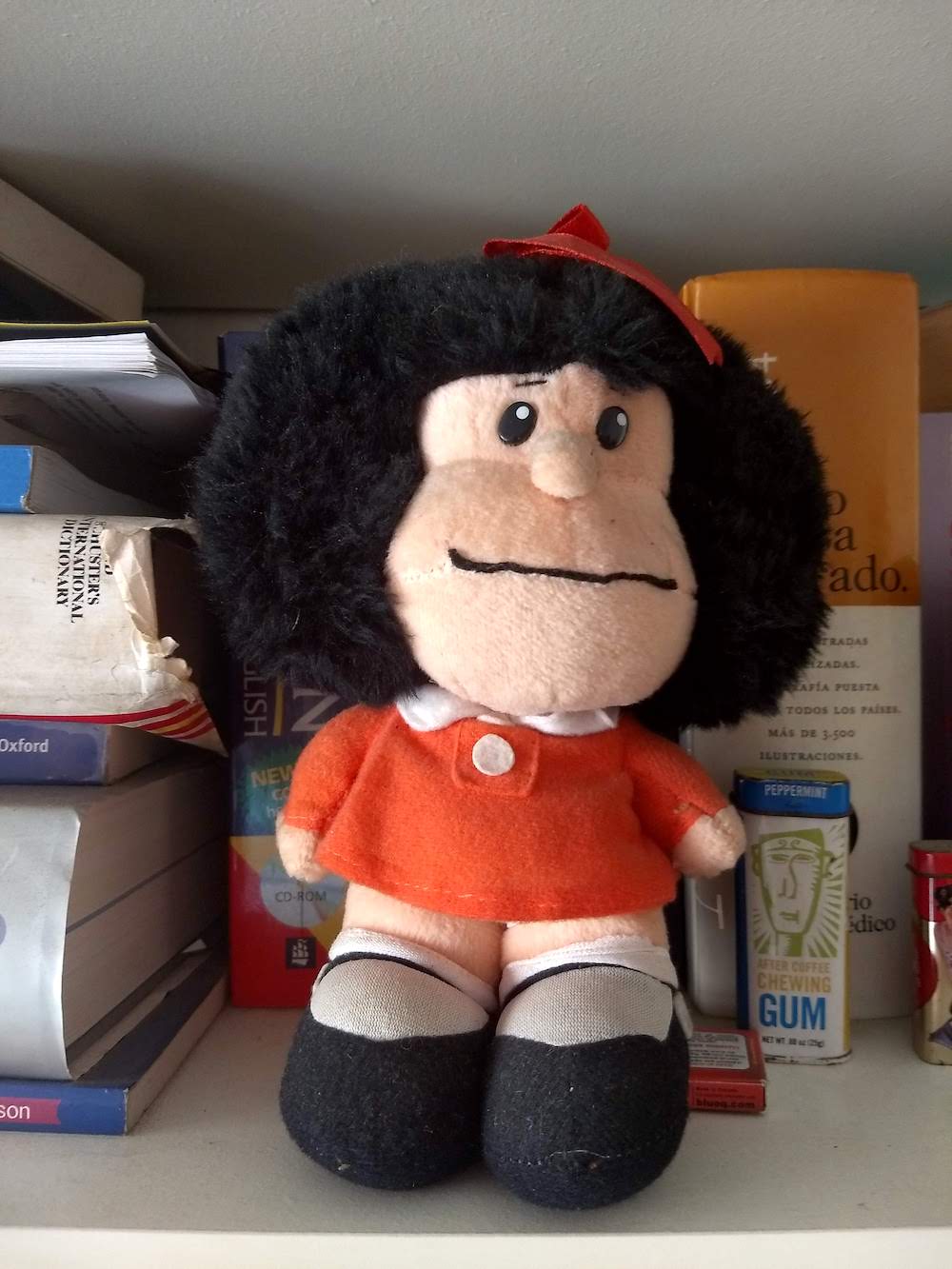Mafalda Doll

Photo: Gabriela Pedranti
One in a (sub-)series of posts contributed to SEMIOVOX’s Object Oriented series by applied-semiotics colleagues and friends from around the world.
I’ve never particularly liked dolls. With the exception of Playmobil — probably because the doll was not the protagonist, you could sail the sea and build cities with them — I didn’t find any comfort or joy in those small models of human beings intended to be cared for as if they were alive. (And if you think about being a kid in the late ’70s and early ’80s, it was sort of scary: I once got a “talking doll” that was almost as tall as me and it brought small plastic records that had to be pressed into her lower back so they would play her voice…)
Among all the dolls that existed when I was a child, the least attractive for me were the stuffed ones; the huge collections on my friends’ beds even scared me. It was quite uncanny: all those dead eyes and fluffy touch where you sleep… No, thanks.
This changed drastically in 2003. Already in my thirties, I had lived in Barcelona for some months and was working in the old part of the city, the so-called Gothic Quarter. I was walking around the area, going back home, when I saw her: an enormous stuffed Mafalda was looking at me from the shop window of a toy shop that had been there for over 100 years (it’s gone now). I couldn’t stop looking at her.
Mafalda is a very well-known comic character from the 1960s, a young girl who was into politics, and also completely critical of the society of her time. Mafalda was the girl we all wanted to be, even as teenagers and adults. It’s still a relevant comic strip in my country of origin, Argentina, and also in other Spanish-speaking cultures. In the shop window, she was surrounded by smaller versions of the other children of the strip: Felipe (always in fear of facing every situation), Susanita (who was defined as the Nobel prize of the middle class), Libertad (“Freedom”, who is smaller than all the others, even if she’s the same age, ahem), Miguelito (from an Italian background, with a Mussolini-lover grandfather), and Manolito (son of a Spanish immigrant, who owns a grocery store, something typical for Spanish immigrants by that time).
I made up my mind: if they had Mafalda in the smaller size, I would purchase it. I left the toy shop with a small bag containing my first-ever stuffed toy. Today, she stands in one of my bookshelves, looking and me when I work or read. She represents, to me, a critical view on life, a constant questioning, and a different point of view on daily situations.
Semioticians’ stories: Josh Glenn on MONKEY WHIMSEY | Malcolm Evans on QUEEN MARY FOB |Lucia Laurent-Neva (England) on TEAL BLUE VOYAGER | Rachel Lawes (England) on DEVIL GREEN | Charles Leech (Canada) on STORMTROOPER WHITE | Ramona Lyons on RABBIT BOX | Matthew De Abaitua on HATCHET | Chris Arning on INKSTONE BROOM | Hamsini Shivakumar on SOUL MOTHER SAREES | Lucia Laurent-Neva on SPONGEBOB BUS | Samuel Grange on SALT & PEPPER HOLDER | Ximena Tobi on VASALISA | Luca Marchetti on TEAPOT | Charles Leech on ORNAMENT | Brian McIntyre on BONE & FLINT NECKLACE | Gabriela Pedranti on MAFALDA DOLL | Sarah Johnson on JOAN OF ARC FIGURINE | Vijay Parthasarathy on BINGO | Aiyana Gunjan on WEDDING DUCKS | Serdar Paktin on NEY | Paulina Goch-Kenawy on VASE | Daria Arkhipova on POKER CHIP | Iván Islas on THERMOS | Sónia Marques on CABBAGE TUREEN | Thierry Mortier on BICYCLE BELL | Louise Jolly on CHALICES | Wei Fen Lee on CURRY PUFF POT | Mariane Cara on MINI WINDSOCK | Malex Salamanques Amiel on MARIA LIONZA | Seema Khanwalkar on THANJAVUR DOLL | Maria Papanthymou on KITCHEN WHISK | Martha Arango on ST. ANTHONY OF PADUA | Max Matus on WOODEN ROBOT | Rasika Batra on PRAYER BEADS | Anastasia Kārkliņa on CHESTNUTS | Maciej Biedziński on HAUNTED SPOON | Shirsha Ganguly on TINTIN FIGURINE | Clio Meurer on GLOW-IN-THE-DARK ROSARY | Enya Autumn Trenholm-Jensen on PINKY RING.
Also see these series: COVID CODES | SEMIO OBJECTS | MAKING SENSE | COLOR CODEX

